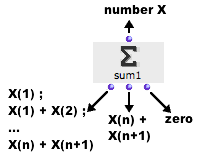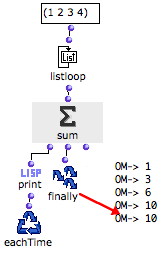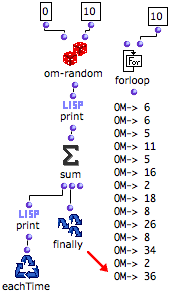| Navigation : Previous | Next |
Sum : Calculating Sums
![]() Sum adds the successive input values.
Sum adds the successive input values.
Inputs, Outputs

Sum has one input and three outputs :
- “what” : collects the successive values coming from other boxes.
- first output :
-
triggers the collection of a new value, and the addition of this value to a sum
-
returns the current value of the sum
- second output : returns the value of the current state of sum
- third output : resets sum to zero.
Examples
Calculating a Sum from a List
The components of a list are returned successively by listloop to sum.
-
At each step of the loop, eachtime triggers and prints the sum of the components.
-
The state of sum at the end of the loop, that is, the sum of all the components of the list, is returned by finally.

Calculating the Sum of N Random Numbers

We now want to calculate the sum of 10 random numbers between 1 and 10.
-
The number of loops is defined by forloop.
-
At each step :
* a random number is returned by **om-random** and printed
* the sum of the successive is returned by **sum** and printed. 3. After ten loops, the iteration is stopped by **forloop**.
- Finally returns the sum of the whole set of numbers returned by om-random.
Contents :
- OpenMusic Documentation
- OM User Manual
- OpenMusic QuickStart
| Navigation : Previous | Next |